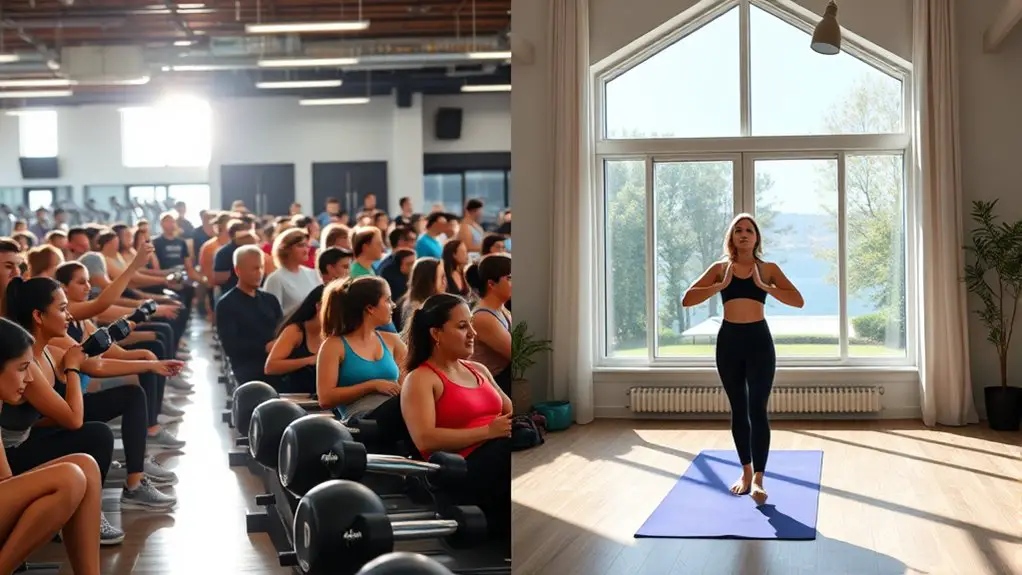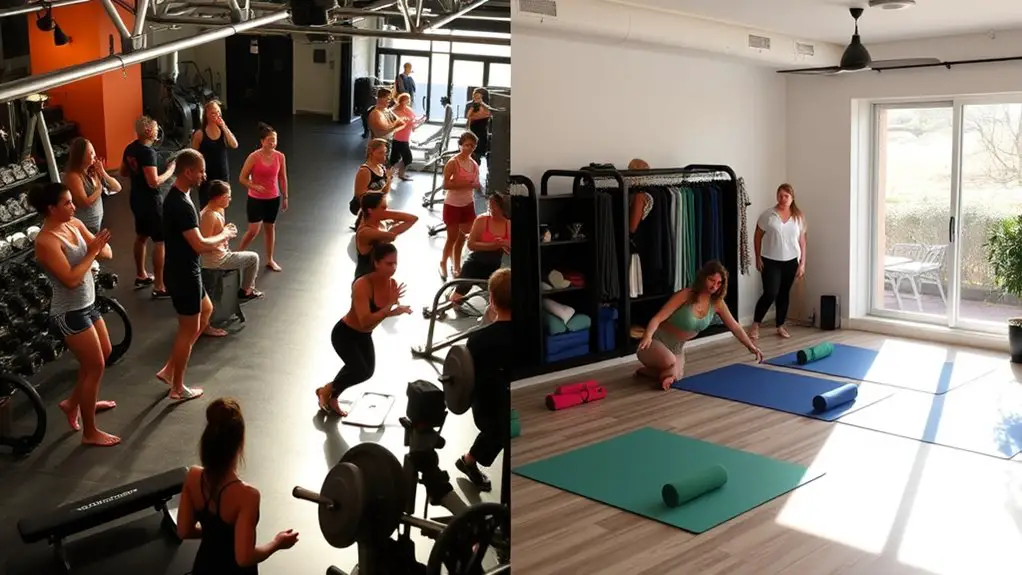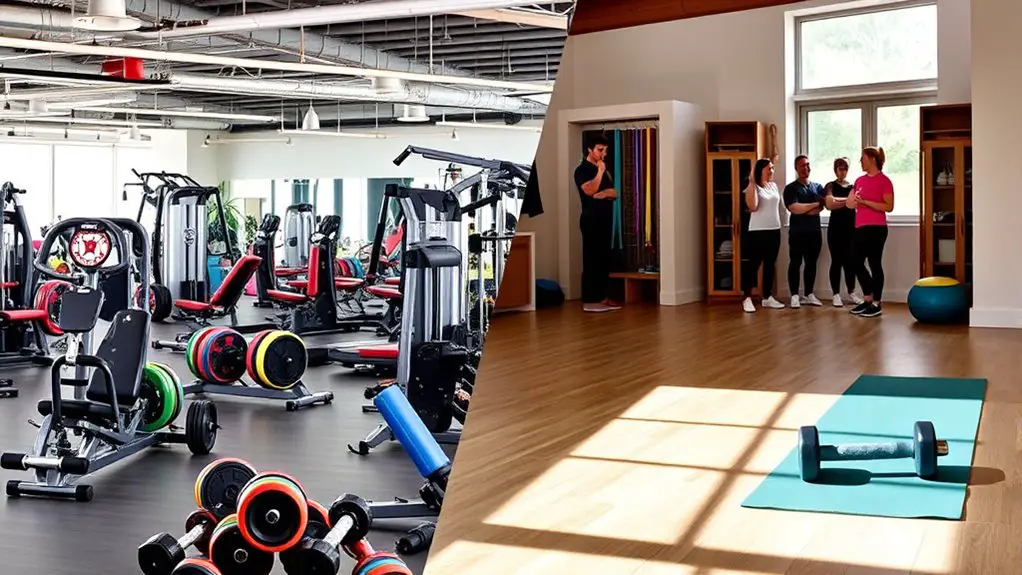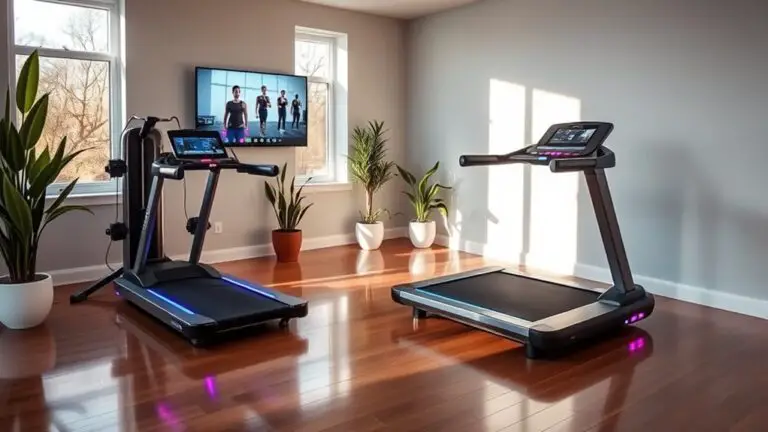How Gym Memberships Compare to Home Workouts

When comparing gym memberships to home workouts, you’ll find unique benefits in each option. Gyms offer varied equipment, group classes, and professional trainers for motivation and support. However, home workouts provide convenience and comfort, allowing you to exercise at your own pace with minimal equipment. Cost is a factor as gyms involve ongoing fees, while home workouts usually have lower ongoing expenses. Exploring your goals and preferences can help you decide which suits you best. There’s more to evaluate as you weigh your options.
The Benefits of Gym Memberships

When you join a gym, you gain access to a wide range of equipment and facilities that can enhance your workout experience. You’ll find everything from free weights to cardio machines, allowing you to tailor your routine to meet your fitness goals safely. Participating in group classes is another significant benefit; they offer a structured environment where you can work out alongside others, boosting motivation while ensuring you’re using the correct techniques.
With professional guidance from trainers available, you can feel confident that you’re using equipment safely and effectively. They can provide personalized advice, helping you avoid injuries while optimizing your workouts. Plus, the supportive atmosphere of a gym can help you stay committed to your fitness journey. Overall, a gym membership not only provides access to diverse resources, but also fosters a community focused on health and safety. Additionally, engaging in regular exercise, such as jump rope techniques, can significantly enhance your cardiovascular fitness.
The Advantages of Home Workouts
Home workouts offer a level of convenience that gym memberships can’t match. You can exercise whenever it suits your schedule, without the worry of crowded spaces or travel time. This flexibility allows you to focus on your safety and comfort, especially during uncertain times.
With bodyweight exercises, you don’t need much equipment—just your own body. This means you can easily adapt your workout to fit the space requirements of your home, whether you have a dedicated workout room or just a corner in your living room. You can create a safe environment that works for you, minimizing distractions and potential hazards found in a gym setting. Additionally, investing in reinforced flooring can help protect your home surfaces while providing a comfortable workout environment.
Moreover, home workouts allow you to progress at your own pace, ensuring you’re not overwhelmed or pushed beyond your limits. Ultimately, the comfort and safety of exercising at home can lead to a more enjoyable fitness journey.
Cost Comparison: Gym vs. Home

Choosing between a gym membership and home workouts often boils down to costs. With a gym, you’ll typically face an initial investment for the membership fee, plus ongoing expenses like monthly dues and potential extra charges for classes or personal training. These costs can add up, especially if you’re not using the facilities regularly.
On the other hand, home workouts require an initial investment in equipment, which can vary widely based on your needs. You might start with just a yoga mat and some dumbbells or go for a full home gym setup. While this upfront cost can seem intimidating, the ongoing expenses are usually minimal—just the occasional purchase of new gear or online classes.
Ultimately, if you value safety and convenience, consider how much you’ll actually use each option to decide which investment makes sense for your budget and lifestyle.
Motivation and Accountability Factors
The decision to work out at a gym or at home also hinges on motivation and accountability. At a gym, you’re surrounded by others who share your fitness goals, which can provide social support that keeps you engaged. Having workout buddies can also foster a sense of safety, as you encourage each other and share tips on safe practices.
On the other hand, home workouts give you the freedom to set your own pace and schedule. However, you’ll need to be more disciplined about goal setting to stay on track. It’s easy to skip a session when no one’s watching, so finding ways to hold yourself accountable is essential. Consider using fitness apps, online communities, or even virtual training sessions to maintain motivation. Ultimately, whether you choose a gym or home workouts, finding a supportive environment will help you reach your fitness goals safely and effectively.
Variety of Workouts and Equipment Availability

When you consider variety in workouts and equipment, gyms often have a significant advantage, offering a wide range of machines, free weights, and specialized classes that cater to all fitness levels. You’ll find specialized equipment designed for everything from strength training to cardio, ensuring you have the tools you need to reach your goals safely.
Plus, many gyms offer group classes led by experienced instructors, providing guidance and support. This not only keeps your workouts fresh but also promotes a sense of community. With options like yoga, spin, or HIIT, you can easily switch things up to avoid boredom and target different muscle groups. Additionally, understanding basic workout principles is crucial for maximizing your gym experience and ensuring safe, effective training.
While home workouts can be effective, they often lack the diverse equipment and expert-led classes found in gyms. If safety and variety are your priorities, a gym membership can offer the resources you need to stay motivated and engaged on your fitness journey.
Flexibility and Convenience of Workouts
While both gym memberships and home workouts have their benefits, flexibility and convenience often tip the scales in favor of exercising at home. When you choose to work out at home, you can manage your time better. You don’t have to account for travel time or gym hours, allowing you to fit workouts into your schedule whenever it works for you.
With home workouts, you can easily adapt your workout scheduling to fit around family commitments, work, or other priorities. If you’re feeling tired or unwell, you can simply adjust your plans without feeling guilty about missing a class. Additionally, exercising at home allows you to create a comfortable environment that feels safe and secure, minimizing any anxiety you might have about crowded gyms. Ultimately, the convenience of home workouts means you can prioritize your health without sacrificing your personal or family commitments.
Personal Preferences and Lifestyle Considerations
Many people find that personal preferences and lifestyle factors play a vital role in deciding between gym memberships and home workouts. If you value a social environment and enjoy group classes, a gym might suit your individual goals better. On the other hand, if you prefer the comfort of home and a private space, working out at home could be the safest option for you.
Time constraints also greatly affect your choice. Gym hours might not align with your schedule, making it challenging to commit. A home workout allows you to exercise at your convenience, fitting in those workouts around your busy life. It’s essential to reflect on what motivates you the most—whether that’s the energy of others or the peace of your own space. Ultimately, choosing what aligns with your lifestyle and meets your individual goals can lead to a more satisfying and sustainable fitness journey.
Frequently Asked Questions
Can I Cancel My Gym Membership Anytime?
Yes, you can usually cancel your gym membership anytime, but it depends on the gym’s cancellation policies. Many gyms require you to give a notice period or may charge cancellation fees. It’s important to check your membership agreement for specifics, as some gyms have strict rules. If you’re worried about safety and your finances, make sure you understand any potential membership fees involved in the cancellation process before proceeding.
Are Home Workouts Effective for Weight Loss?
If you’re aiming for a transformation like Hercules, home workouts can definitely help you shed pounds. The key is maintaining a caloric deficit; when you burn more calories than you consume, weight loss follows. You’ll need to focus on workout consistency, too. By sticking to a regular routine, you not only build strength but also boost your confidence. Just remember to prioritize safety, listen to your body, and choose exercises that suit your fitness level.
Do Gyms Offer Personal Training Sessions?
Yes, most gyms do offer personal training sessions, which can be a huge advantage if you’re looking for guidance. With a personal trainer, you’ll receive tailored workouts that fit your goals and guarantee you’re using the equipment safely. Plus, gym benefits like access to specialized machines and group classes can enhance your experience. Working with a trainer can help you stay motivated and accountable, making your fitness journey more effective and enjoyable.
What Equipment Do I Need for Home Workouts?
Did you know that nearly 60% of people who workout at home use minimal equipment? For your home workouts, a solid dumbbells selection is essential, as they’re versatile and great for strength training. Resistance bands are another must-have; they’re safe and effective for various exercises, helping you build muscle without risking injury. Start with these items, and you’ll create a safe, effective workout environment right in your living room!
How to Stay Motivated for Home Workouts Long-Term?
Staying motivated for home workouts long-term can be a challenge, but you can make it easier. Start with clear goal setting; having specific, achievable targets keeps you focused. Incorporating workout variety is key too—mix up your routines with different exercises to prevent boredom. Remember to listen to your body and prioritize safety; if something feels off, it’s okay to adjust. Celebrate your progress, and keep yourself accountable to stay on track!





